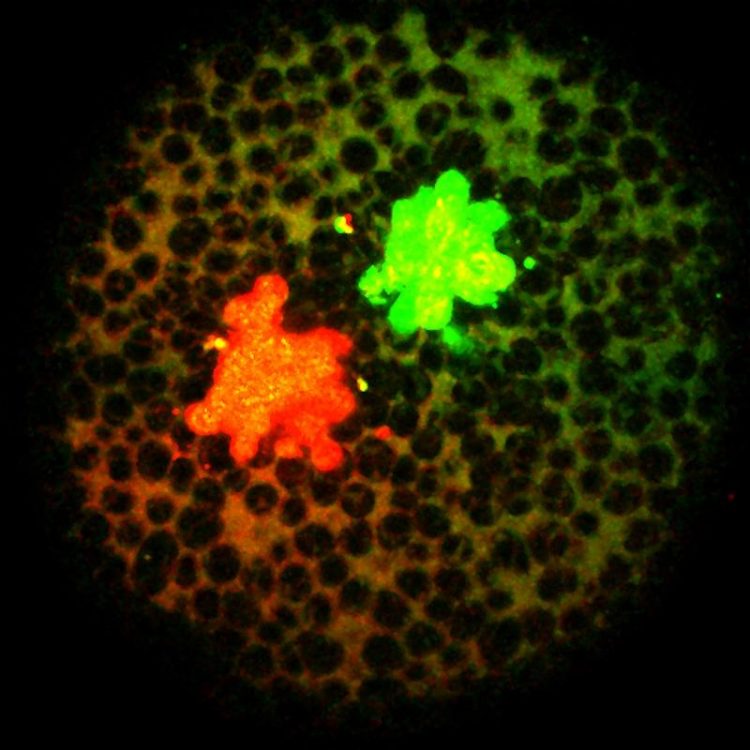How the proper ratio of signaling molecules controls early embryonic development

The signaling molecules labeled with fluorescent proteins. Friedrich Miescher Laboratory, Tübingen/ Germany
This basic mechanism of early embryonic development may also help to guide tissue engineering approaches for regenerative medicine in the future. The findings were published in the scientific journal Cell Reports.
It is like a well-choreographed dance: During early embryonic development, cells differentiate and move from an apparently chaotic clump to their final destination. In this way, patterns emerge from the cell clump, and the axes of the embryo develop along which the body parts emerge.
Signaling molecules organize the choreography of this dance piece. They assign the immature cells their place in the embryo and ensure that they take on the intended role and function during their maturation process, so that for instance limbs or organs can form.
The choreographers, the key factors in early embryonic development, include the signaling molecules Nodal and BMP. Nodal determines where the interior of the embryo will be, and BMP determines where the belly (ventral) and the back (dorsal) will arise.
These two signaling molecules are also responsible for the formation of the head-to-tail body axis. Strikingly, when Nodal and BMP are artificially introduced into zebrafish embryos, these signaling molecules can even trigger the formation of a complete secondary axis – a Siamese twin.
The proper ratio between Nodal and BMP is decisive for the development of the axes.
“A gradient along the axes is created from both molecules, and depending on how much Nodal or BMP is present, the fate of the embryonic cells in this area is determined,“ explains Gary Soh, first author of the publication.
“If there is a lot of Nodal but little BMP, head structures are created; if the ratio is inverse and BMP is higher, a tail forms. However, so far it has been unclear how this gradient is created and how the cells of the embryo respond to this gradient.“
To address this question, Soh and colleagues labeled zebrafish Nodal and BMP with fluorescent proteins and tracked the formation of the resulting secondary axes. Since zebrafish embryos are transparent, the researchers were able to observe how both signaling molecules become distributed in the embryo. The surprising result: Nodal and BMP have very similar distributions.
So how are these distributions read out, such that the cells along the embryonic body axis assume different identies and perform different functions? This is where additional signaling molecules come into play: molecules of the so-called Smad family.
Nodal and BMP activate these molecules – but not equally, as the scientists found out.
Using mathematical modeling and precise measurements, they showed that Nodal stimulates the activation of Smad2 relatively slowly, whereas BMP activates Smad5 very quickly.
As a consequence, different concentrations of the Smad molecules arise along the emerging axis. “We found that cells develop along different paths depending on the ratio between activated Smad2 and Smad5,” explains Soh.
“These different ratios seem to create a kind of code that ultimately controls what cell type forms where“.
The scientists have revealed a fundamental mechanism of early embryonic development, which in the long term might also help to guide approaches for the differentiation of stem cells into specific tissues for regenerative medicine.
Prof. Dr. Patrick Müller
Friedrich Miescher Laboratory
Max Planck Research Group “Systems biology of development”
Phone: +49 7071 601-815
Email: patrick.mueller@tuebingen.mpg.de
Soh GH, Pomreinke AP, Müller P (2020). Integration of Nodal and BMP signaling by mutual signaling effector antagonism. Cell Reports, 31:107487.
Media Contact
More Information:
http://www.fml.mpg.deAll latest news from the category: Life Sciences and Chemistry
Articles and reports from the Life Sciences and chemistry area deal with applied and basic research into modern biology, chemistry and human medicine.
Valuable information can be found on a range of life sciences fields including bacteriology, biochemistry, bionics, bioinformatics, biophysics, biotechnology, genetics, geobotany, human biology, marine biology, microbiology, molecular biology, cellular biology, zoology, bioinorganic chemistry, microchemistry and environmental chemistry.
Newest articles

Bringing bio-inspired robots to life
Nebraska researcher Eric Markvicka gets NSF CAREER Award to pursue manufacture of novel materials for soft robotics and stretchable electronics. Engineers are increasingly eager to develop robots that mimic the…

Bella moths use poison to attract mates
Scientists are closer to finding out how. Pyrrolizidine alkaloids are as bitter and toxic as they are hard to pronounce. They’re produced by several different types of plants and are…

AI tool creates ‘synthetic’ images of cells
…for enhanced microscopy analysis. Observing individual cells through microscopes can reveal a range of important cell biological phenomena that frequently play a role in human diseases, but the process of…





















